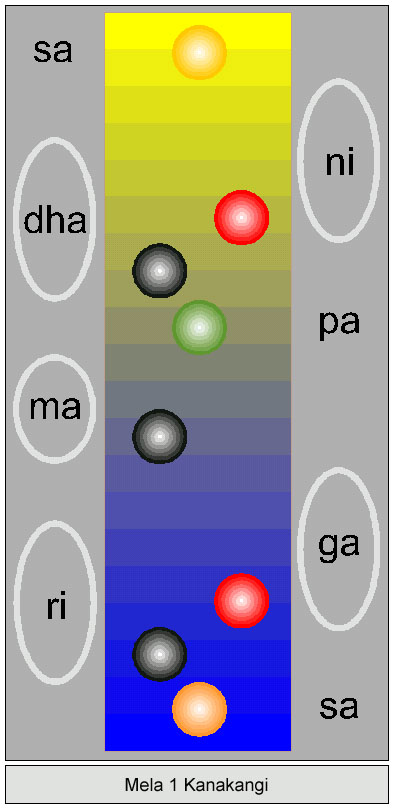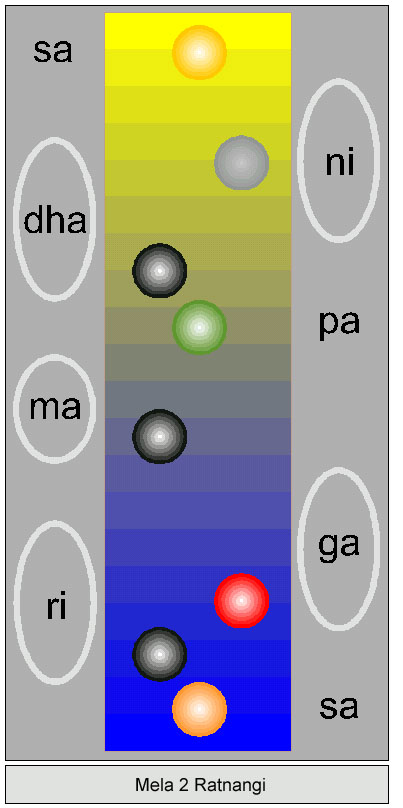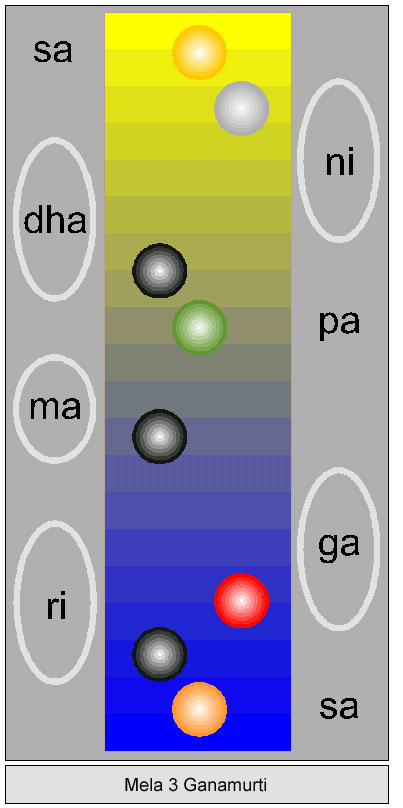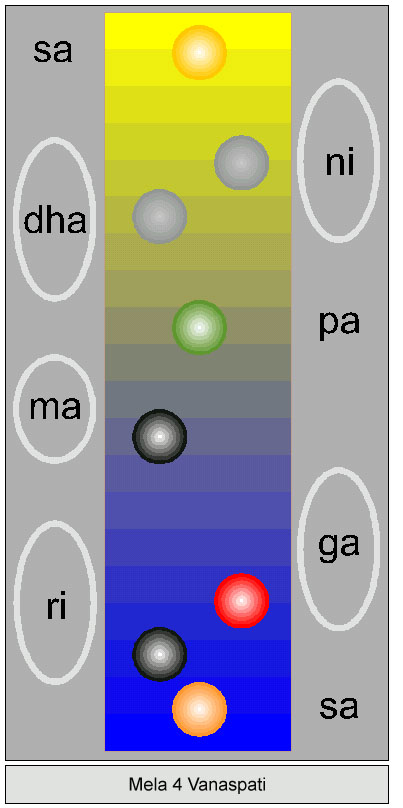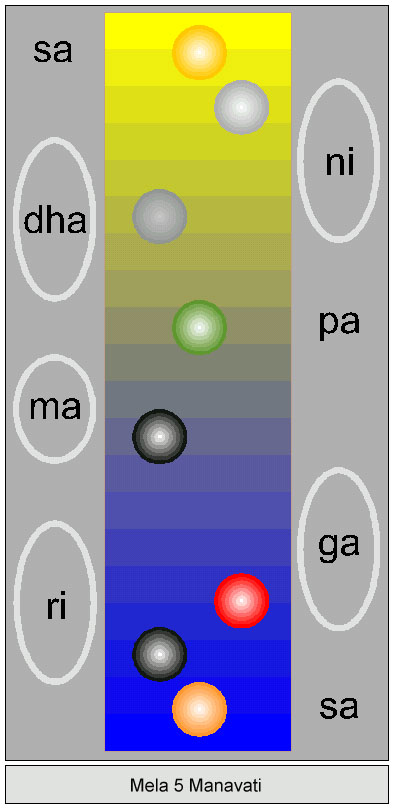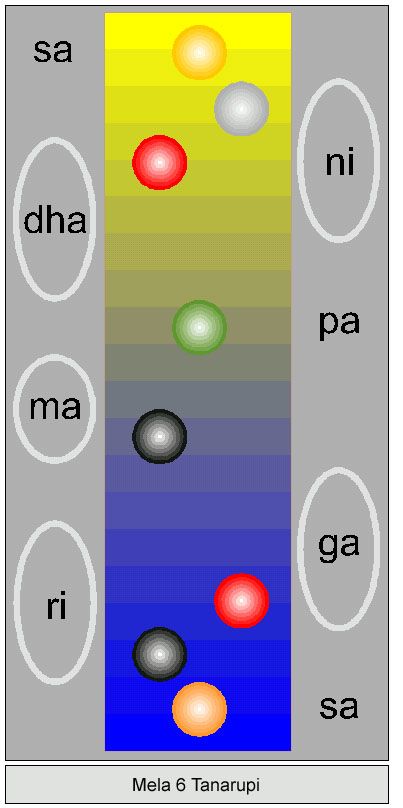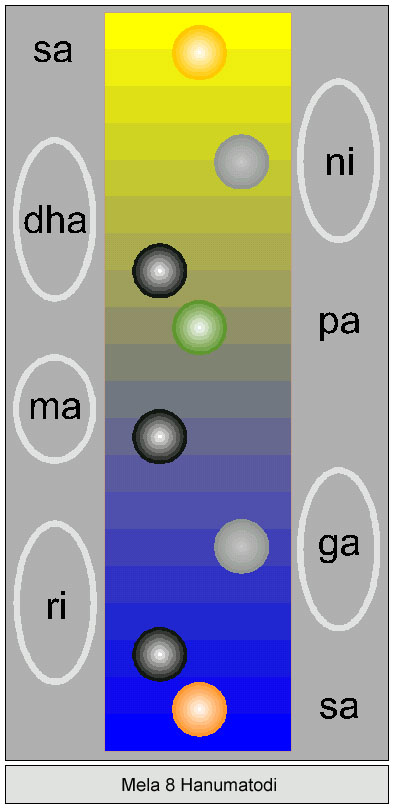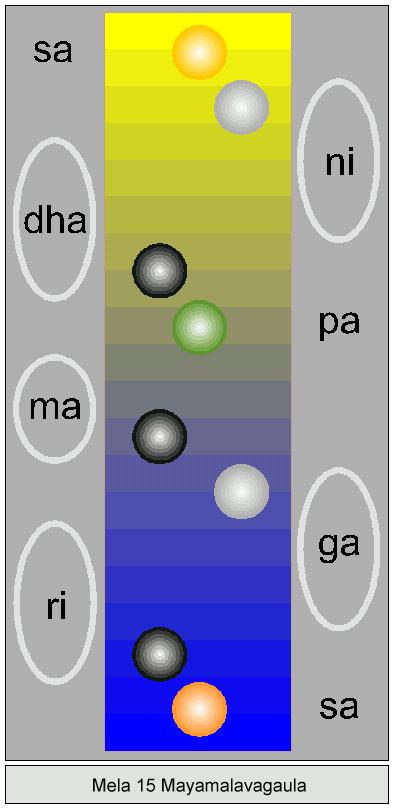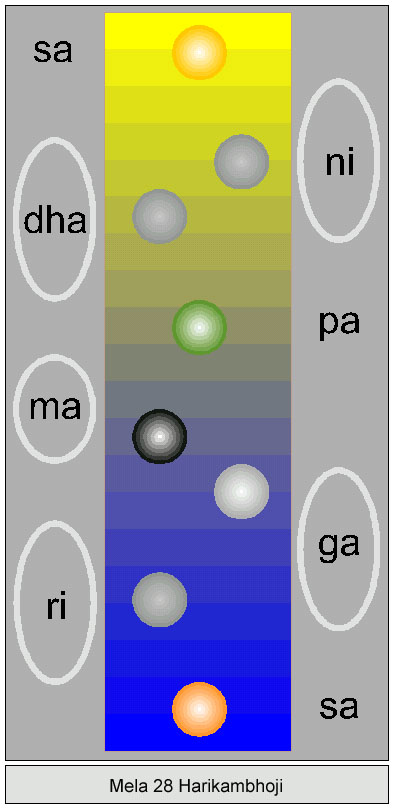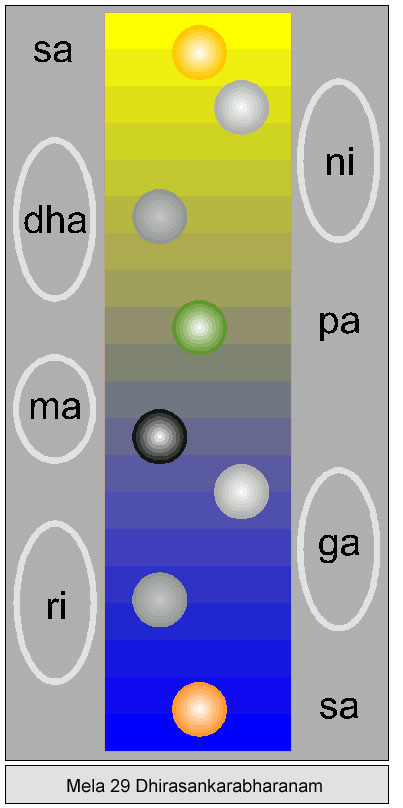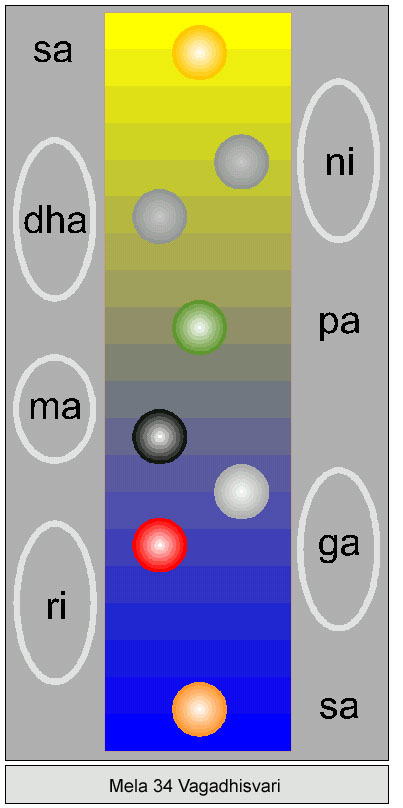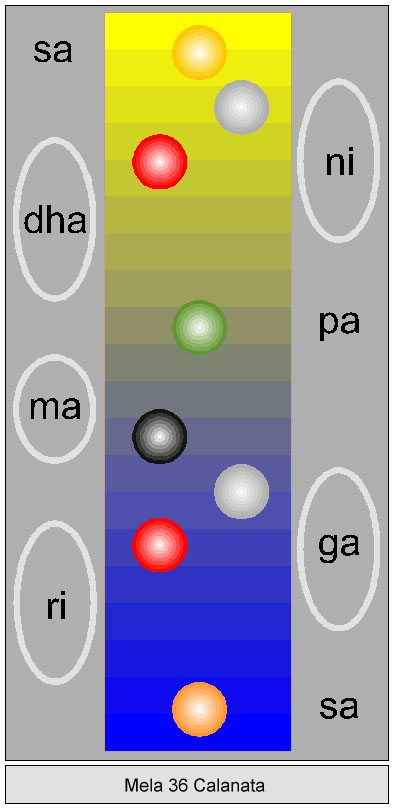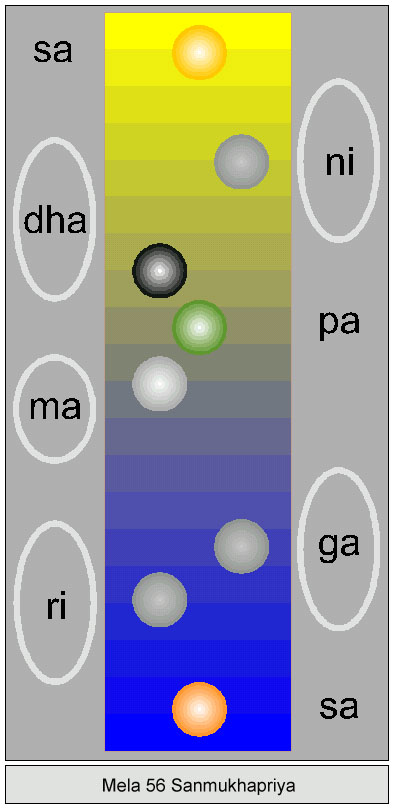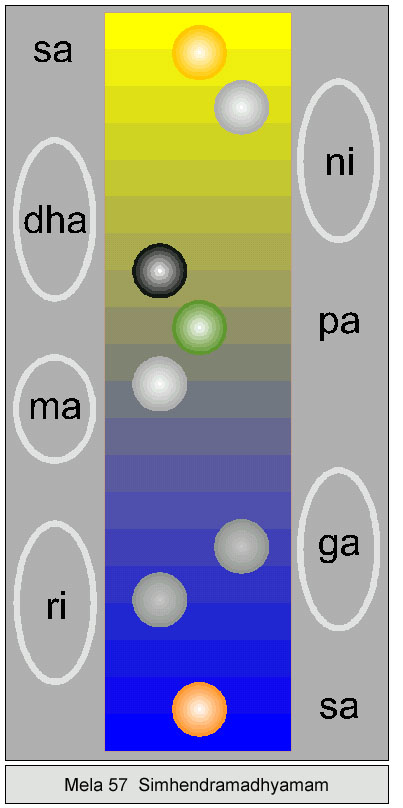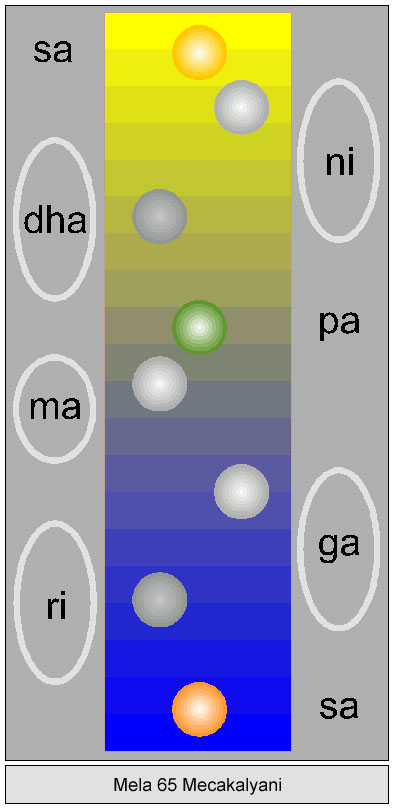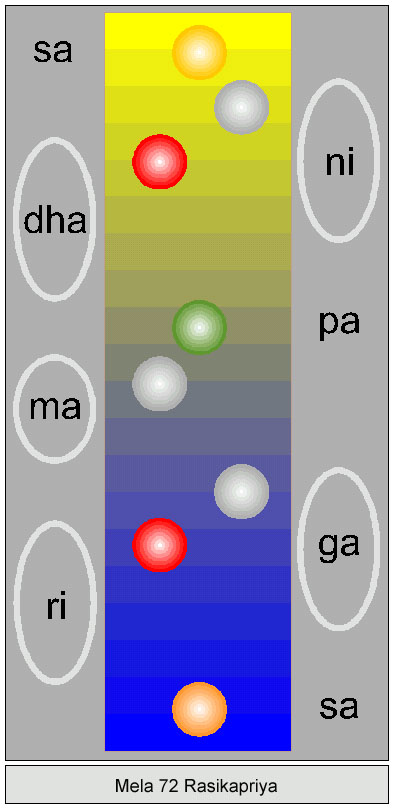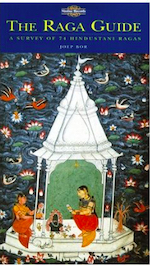12 positions are available in the South Indian 72 mela system
to learn more, read the following explanations
Source © Ludwig Pesch under the
Creative Commons Attribution-NonCommercial-NoDerivs 3.0 Unported License
A scale – mēla in Carnatic or thāt in Hindustani music – isn’t a raga yet: it is no more than an imaginary arrangement of notes for the formation of “parental scales”. From 72 Carnatic mēla scales and their 10 thāt counterparts in Hindustani music, a wide range of major and minor ragas are thought to have been “derived” over a period of several centuries.((Most ragas cannot be said to actually have been “derived” from any pre-existing scale but instead, they came to be associated with a particular “parent scale” much later on, as seen in ongoing debates among music scholars and performers.))
Listen to a recitation of melakarta names: Akshara Samskriti >>
Thinking of a particular scale enables musicians and learners to distinguish ragas from one another, which became increasingly useful as hundreds of other ragas came to performed on a regular basis.((There are many reasons for such an increase in the number of ragas since the late 19th century; this includes greater pride in India’s cultural heritage displayed by a growing middle class: men – and increasingly women – willing devote their leisure time to an art formerly seen as the domain of specialists patronized by temples, courts and merchants for rituals and festive occasions; and with the arrival of the printing press, music primers became a lucrative proposition for scholarly musicians besides being affordable and time saving for non-professional learners.)) Joep Bor aptly defines a raga “as a tonal framework for composition and improvisation; a dynamic musical entity with a unique form, embodying a unique musical idea.”((“As well as the fixed scale, there are features particular to each raga such as the order and hierarchy of its tones, their manner of intonation and ornamentation, their relative strength and duration, and specific approach. Where ragas have identical scales, they are differentiated by virtue of these musical characteristics. […] Most importantly, a raga must evoke a particular emotion or create a certain ‘mood’, which is hard to define, however. As the term raga itself implies, it should ‘colour’ the mind, bring delight, move the listeners and stimulate an emotional response. In other words, the concept of raga, which has evolved over a period of two millennia, eludes an adequate brief definition.” – Joep Bor, ‘What is a raga?’, p. 1 in The Raga Guide: A Survey of 74 Hindustani Ragas, Nimbus Records with Rotterdam Conservatory of Music first published in 1999))
For this purpose 7 notes occupy certain positions within an octave as seen in the above illustrations. These notes are framed by an 8th note (“octave”) which corresponds to the basic note, now placed in the higher range. Listening carefully to the middle strings of tambura will reveal this higher note (tāra sa).((Flow | Practice within a shared vocal range of one octave helps learners to explore different scale patterns on a daily basis with reference to well established methods.))
To understand their relative positions watch the above slideshow repeatedly. Nevertheless the basic idea underlying all of India’s “classical” Indian music traditions – the proverbial “seven notes” (saptasvara) as basis for melody – remains untouched.
Note: The above series of images illustrates 16 out of a total of 72 melas with the names of their corresponding melakarta ragas, including the first six melas (01. – 06.) and the last one (72.); and several others that have long played a prominent role concerts either as melakarta ragas (i.e. featuring all the seven notes) or derivatives known as janya raga (08., 15., 28., 29., 34., 36., 56. 57. and 65). The latter may feature less than seven notes, be characterized by “zigzag” patterns or notes not found in their parental scales.
So a total of 12 positions are available in the South Indian mela system whereby the basic note “sa” and its fifth “pa” are the starting points of two series of 4 notes:
sa-ri-ga-ma & pa dha ni (upper) sa
reversed and sung for the sake of memorization as follows:
(upper) sa-ni-dha-pa & ma-ga-ri-sa
Please note that – unlike in western “classical” music – the actual pitches are never given but chosen to suit one’s own vocal range or a particular instrument (e.g. flute and vina which come in different sizes and tonal ranges). This means: sa may correspond to “C” on your keyboard or for a male voice (just like “D”); but for a female voice, sa is more likely to correspond to “F” or “G” instead.
Last but not least, singing or playing a raga entails attention to subtle tonal shades just as embellishments (gamaka) as heard in a proper concert performance. So what you hear isn’t merely “a clever combination of notes” derived from some scale or other: raga based music is all about musical – even lyrical – expression, carefully regulated by certain rules and practiced in accordance with well established patterns.
In the meantime, an ever growing diversity accelerated the search for effective teaching methods suited to raga based music. In South Indian music this was achieved with the help of the melakarta scheme (72 scale abstract patterns).
Even today “tune smiths” continue to fill in the blanks left by their revered predecessors, including novelties inspired by Beethoven’s most beloved piano piece worldwide (you guessed it …)!
Interestingly the 72 mela system came to serve a dual purpose, one not found in other music traditions as regards scope: in addition to the intention proclaimed by its “inventor” Venkatamakhin in the late 17th century, namely to widen the scope for musical expression, it became a mnemonic system (aid to memory) for musicians and teachers alike.
A glance at any music textbook and most song collections of Carnatic music will show how this was achieved since music publishing began to flourish in the early 19th century.
A highly condensed demonstration of the above concept is rendered here: The 13-part Sanskrit composition of Chitravina N Ravikiran (duration: 7 min.) >>
For a more detailed application, listen to the 72-Melaragamalika rendition by Smt Kiranavali’s students at Cleveland Aradhana 2014_Part 1; click/bookmark part 1 of this recording here; and click here for Part 2 >>
More about the 72-Melaragamalika sung by Smt Kiranavali’s students
The entire ragamalika [by Maha Vaidyanatha Iyer (1844 – 1892 AD)] is set to Adi tala. The Pallavi is sung in Sriragam, followed by some beautiful jati phrases in Tillana style. There is no Anupallavi and the Charanam has 72 lines, one for each melakarta, with the raga mudra skillfully inscribed in each line. At the end of each mela raga, there is a Chittaswara, and further, to enhance the beauty of the composition, his brother Ramaswami Sivan added additional Chittaswaras at the end of each line, whose poorvanga (first half) is in the same raga, but the uttaranga (second half) is in the next raga. At the end of each Chakra (6 raga cycle), the Pallavi is repeated. At the commencement of the Prati madhyama series, the jati phrases are also sung.
Source: MAHA VAIDYANATHA IYER AND HIS 72 – MELA RAGAMALIKA http://carnatica.net/special/mahavaidyanathaiyer.htm
This is not a piece we hear often in concert platforms. Occasionally in the past, one or two Chakras of this lengthy composition has been rendered by Musiri Subramanya Iyer and M S Subbulakshmi. Recently (June 1989), the Gramaphone Co. of India (HMV) released an album (LP No. ECSD 40552), and simultaneously a 60-minute casette (No. HTCS 03B 3346) under the title ‘Mela Ragamalika Chakra’, where M S Subbulakshmi has melodiously rendered this divine ragamalika, with all the above-mentioned features and Chittaswaras.
Related: https://www.carnaticstudent.org/learn-to-distinguish-and-remember-the-72-melakarta-ragas-free-course >>

